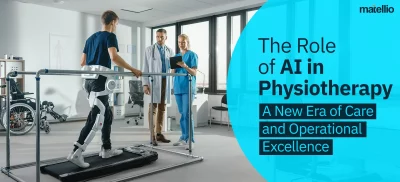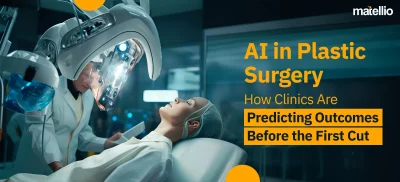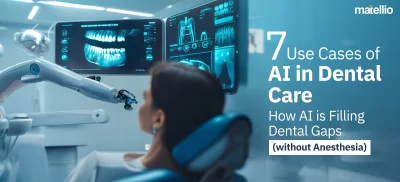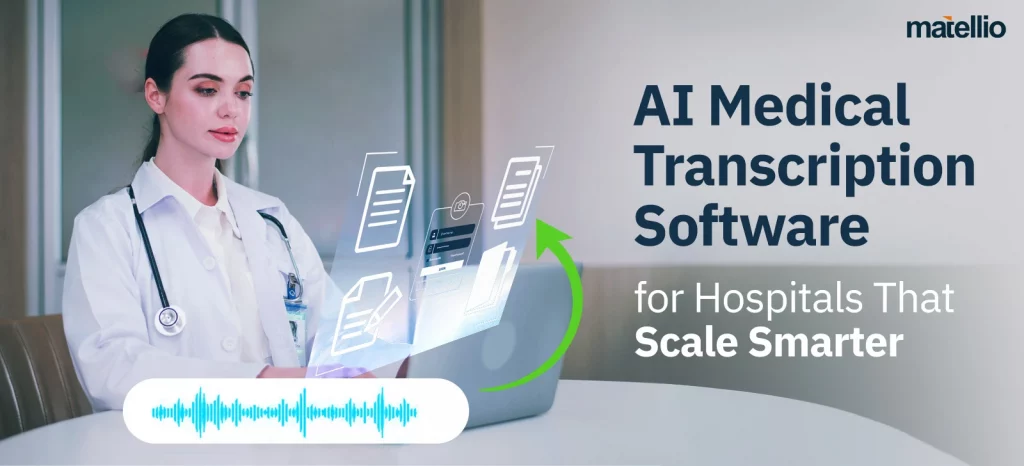
Despite rapid strides in diagnostics and digital health tools, one issue continues to slow down clinical efficiency across the board—medical documentation. Healthcare providers, especially in high-volume environments like primary care, are grappling with overwhelming administrative loads that eat into their core responsibility: delivering patient care. That’s exactly where custom AI medical transcription software becomes not just helpful but mission critical.
According to a recent study, primary care physicians spend more than one-half of their workday—nearly 6 hours—interacting with the EHR during and after clinic hours. This includes typing up notes, organizing charts, inputting billing codes, and searching for patient data. The time spent on such tasks contributes directly to provider burnout, patient dissatisfaction, and operational drag.
Even with modern EHR platforms, the documentation process remains tedious, inconsistent, and prone to error. Manual transcription leads to delayed record updates, compliance risks, and information gaps across departments.
AI-driven transcription tools are helping providers reclaim lost hours and reduce documentation fatigue. And when built with specialty workflows in mind, medical transcription software isn’t just solving the paperwork problem—it’s redefining how care gets delivered.
What Happens Without a Custom AI Medical Transcription Software?
Hospitals and healthcare teams striving for speed, accuracy, and compliance often find themselves held back by outdated documentation methods. Below are five critical challenges that emerge in the absence of intelligent transcription—and how custom-built AI medical transcription software solves them with precision.
Burnout from Manual Charting
Without intelligent automation, physicians are forced to spend hours documenting visits—often late into the night—resulting in exhaustion and disengagement. This inefficiency is one of the growing concerns in the rise of AI in healthcare, where smart systems aim to reduce cognitive load and reclaim clinical time.
Solution: A custom-built platform transcribes, and formats notes in real-time, reducing after-hours work and allowing clinicians to focus on patients, not paperwork.
Risk of Errors and Inconsistencies
Manual dictation and typing can lead to omissions, typos, and inconsistent note structures—putting patient safety and legal compliance at risk. This is where reliable speech recognition software for medical transcription becomes essential, ensuring standardized and error-free documentation.
Solution: AI-powered tools ensure high accuracy and consistency by using medical language models that learn from real-world data, minimizing documentation errors and legal exposure.
Delays in Chart Updates and Follow-Ups
Slow transcription or charting lag delays care plans, specialist referrals, and follow-up actions, impacting care continuity. In a rapidly growing medical transcription software market, speed is no longer a bonus—it’s the baseline.
Solution: A custom-built solution enables near-instant EHR syncing and automated tagging, ensuring that charts are up to date before the next patient even walks in.
One-Size-Fits-No Workflows
Generic transcription tools can’t adapt to the nuanced needs of different specialties, languages, or compliance layers. Organizations need AI-driven healthcare solutions that flex around diverse workflows and do not force-fit a static model.
Solution: With custom-built medical transcription AI software, workflows are tailored to departments—whether it’s SOAP notes in primary care or multi-speaker logs in mental health.
Data Silos and Integration Friction
Without interoperability, transcribed data sits in isolation—forcing staff to copy-paste between systems or re-enter data manually. A modern HIPAA compliant transcription software ensures secure, seamless integration with EHRs and related platforms.
Solution: Custom-built platforms integrate directly into EHRs, scheduling tools, and billing systems, creating a documentation ecosystem that flows effortlessly across teams and tools.
Not Just Off-the-Shelf: Why Customization Is the Key to Success
Generic transcription tools may check boxes—but when it comes to clinical documentation, only custom-built AI medical transcription software can deliver the accuracy, adaptability, and compliance healthcare teams truly need. And with AI adoption skyrocketing in healthcare, customization is no longer optional—it’s a strategic necessity.
According to recent projections, the global medical transcription software market was valued at USD 16.61 billion in 2024 and is expected to reach USD 630.92 billion by 2033, growing at a CAGR of 49.8%. This growth signals an industry-wide shift toward more intelligent, secure, and integrated documentation tools.
Challenge: One-Size-Fits-No Tools
The problem: Most SaaS-based software for medical transcription is designed for mass use, lacking the flexibility to support specialty-specific terms, formats, or compliance needs.
Why it matters: In high-stakes care environments, using rigid tools often results in increased corrections, staff frustration, and underutilized systems. By leveraging AI driven healthcare solutions, providers can deploy models trained on their own clinical workflows, ensuring both linguistic accuracy and process efficiency.
Need: Workflow-Specific Training Models
The problem: A radiologist’s report, a psychiatric evaluation, and a surgical discharge summary all follow different linguistic and structural norms.
Why it matters: Generic systems lack the sophistication to understand context—and that leads to misinterpretation, inefficiency, or worse, medical risk. With customized medical transcription AI software, departments receive models tailored to their vocabulary and flow, improving documentation speed and clinical trust.
Need: Alignment with Internal Protocols
The problem: Off-the-shelf tools rarely reflect how your teams record, review, and report documentation.
Why it matters: Misalignment forces clinicians to work around the system, which defeats the purpose of automation and reduces platform adoption. A HIPAA compliant transcription software ensures not only legal alignment but also support for your audit trails, note formats, and approval protocols.
Solution: Matellio’s Custom-Built Advantage
As a seasoned software development company, Matellio designs every transcription solution to fit the exact needs of your organization—right down to specialty, team structure, and care protocols.
What we deliver:
- Department-trained AI transcription engines
- EHR, scheduling, and billing integrations
- Support for multi-lingual and multi-specialty environments
- Custom reporting templates and real-time feedback loops
- Built-in security and encryption aligned with compliance mandates
Ready To Reimagine Documentation with Custom Transcription Solution? In the race to modernize clinical documentation, healthcare providers can no longer rely on outdated, one-size-fits-all tools. Today’s custom-built AI medical transcription software must be equipped with next-gen capabilities that go beyond basic speech-to-text. These features not only ensure transcription accuracy—but also drive real-time integration, regulatory compliance, and scalable performance. Here’s a look at the high impact features every healthcare organization should demand from their transcription system: When it comes to handling sensitive patient data, there’s no room for error. Every line transcribed by your AI medical transcription software must meet the highest standards of security, privacy, and regulatory compliance. For hospital leaders and IT heads, choosing the right solution means going beyond accuracy—it’s about trust, transparency, and long-term governance. Here’s what you should look for in a truly secure and compliant transcription platform: Leading platforms in the medical transcription software market come pre-equipped with embedded compliance frameworks. That includes HIPAA for U.S. healthcare, GDPR for European data privacy, and HL7 for seamless interoperability—minimizing risk, boosting readiness, and reducing the time and cost of external validation. Security must be proactive. That’s why enterprise-grade speech recognition software for medical transcription now includes multi-factor authentication (MFA), audit logs, and tiered user permissions—ensuring that only authorized personnel can access, edit, or route sensitive patient records. Every healthcare organization has unique operational constraints. Whether you choose cloud-based scale or local control, your HIPAA-compliant transcription software must support encrypted on-premises and cloud deployments with options for data residency, backup, and disaster recovery compliance. Modern software for medical transcription goes beyond text conversion—it provides real-time logs, traceability, and access histories. These features support accountability, ensure governance, and simplify regulatory audits, all while reinforcing trust in how patient data is managed. Security is not a siloed function—it works best when integrated across your digital ecosystem. With advanced AI integration services, your transcription platform should plug into SIEM systems, compliance dashboards, and EHR platforms to offer real-time alerts, monitoring, and automated reporting. At Matellio, we understand that healthcare is no place for generic solutions. In an industry where accuracy, speed, and compliance are non-negotiable, your transcription platform must be tailored not only to clinical standards—but also to your organizational DNA. That’s where our deep domain expertise and AI engineering capabilities converge to create truly transformative solutions. Here’s how we help healthcare providers build custom AI medical transcription software that doesn’t just capture documentation—it elevates it. We don’t believe in “one-size-fits-all.” From multi-specialty hospitals to niche behavioral clinics, we design transcription systems tailored to your documentation styles, departmental needs, compliance structure, and user workflows. Our AI engineers leverage deep learning and natural language processing to build models that understand the clinical context—not just transcribe words. We fine-tune these models using real-world audio, specialty-specific terminologies, and structured data from your environment to ensure high transcription accuracy and clinical relevance across every department. Using our AI development services, we connect your transcription tool with leading EHR platforms like Epic, Cerner, or MEDITECH—as well as your internal scheduling, billing, and data archiving systems. The result? Smooth, secure, and bi-directional data flow with minimal disruption to your existing infrastructure. We incorporate compliance from day one. Your solution is designed to meet the highest standards of HIPAA, HL7, and GDPR compliance. Our systems are delivered with secure APIs, encrypted data storage, audit trails, and role-based access—making your transcription platform enterprise-ready and audit-proof. In short, Matellio isn’t just a tech vendor—we’re your strategic partner in developing AI medical transcription software that delivers clinical-grade precision, operational efficiency, and real-world usability. Fill out the form to schedule a consultation with our AI healthcare specialists today. Next-Gen Feature: What It Brings to the Table
Next-Gen Feature
What It Brings to the Table
Medical NLP Engine
Understands complex medical terms, context, and clinical shorthand for precise note generation
Real-Time EHR Integration
Syncs transcribed data instantly with platforms like Epic, Cerner, and MEDITECH
Multi-Speaker Diarization
Accurately separates voices in group consults, surgeries, or team-based care discussions
Smart Auto-Coding
Suggests ICD/CPT codes during transcription to reduce billing errors and speed up claims
Context-Aware Sentence Structuring
Converts fragmented dictation into clean, structured summaries for better readability
Built-In Compliance Frameworks
Includes HIPAA, HL7, and GDPR modules to secure sensitive data and streamline audits
Multilingual Speech Support
Transcribes conversations in multiple languages, serving diverse patient populations
Voice Biometrics for Authentication
Adds an additional layer of identity verification to sensitive workflows
Customizable Templates by Department
Enables different note styles (SOAP, DAP, etc.) per specialty or clinical use case
Compliance and Data Protection in AI Medical Transcription Software
Built-in compliance with HIPAA, HL7, and GDPR
Multi-factor authentication and Role-Based Access
Flexible Deployment: On-Premise or Secure Cloud
Transparent Data Handling and Audit Trails
Seamless Integration
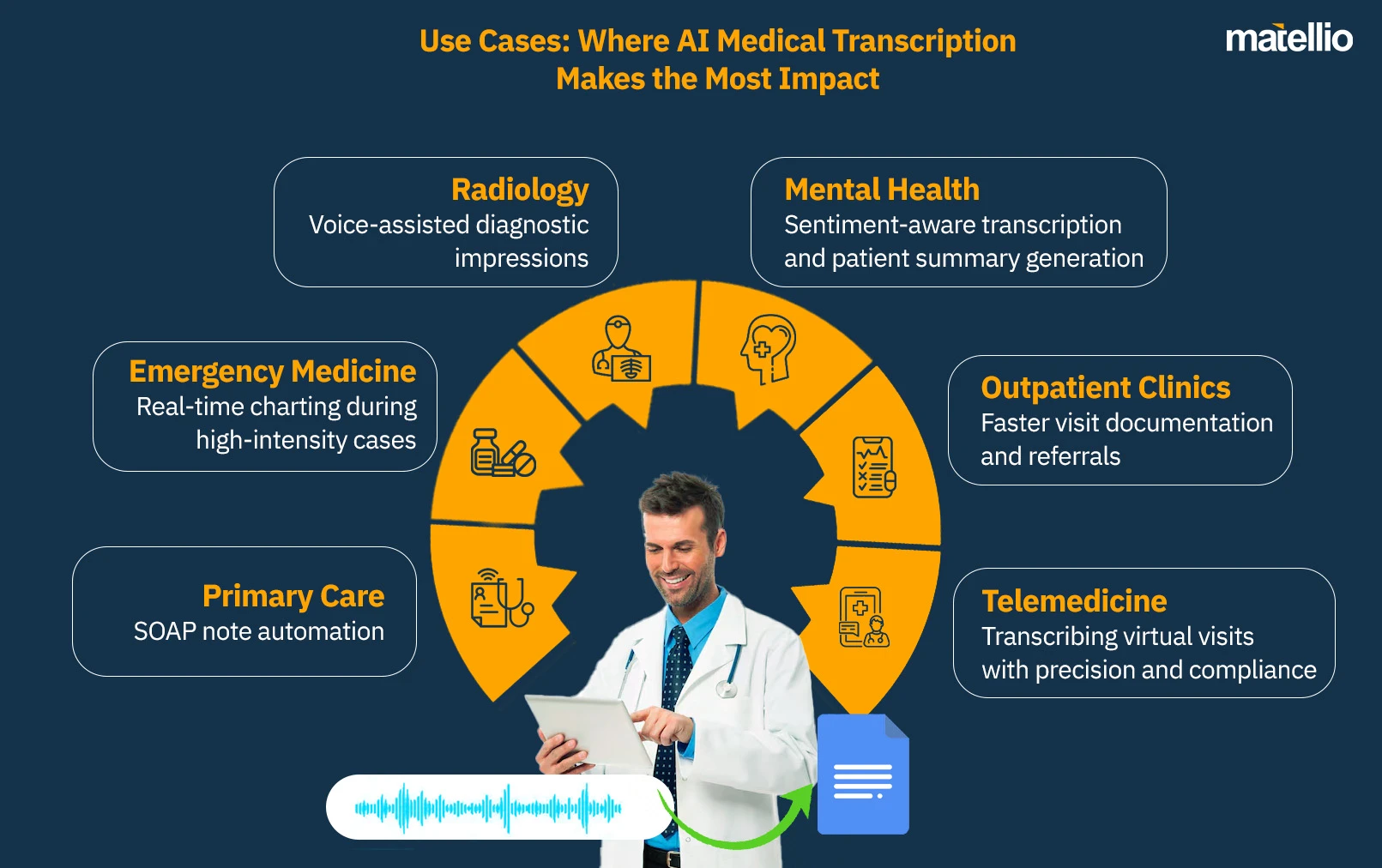
How Can Matellio Help in Developing AI Medical Transcription Software?
Custom Architecture, Built Around You
Domain-Trained AI & NLP Models
Seamless EHR and System Integration
Built-In Compliance & Security Frameworks
